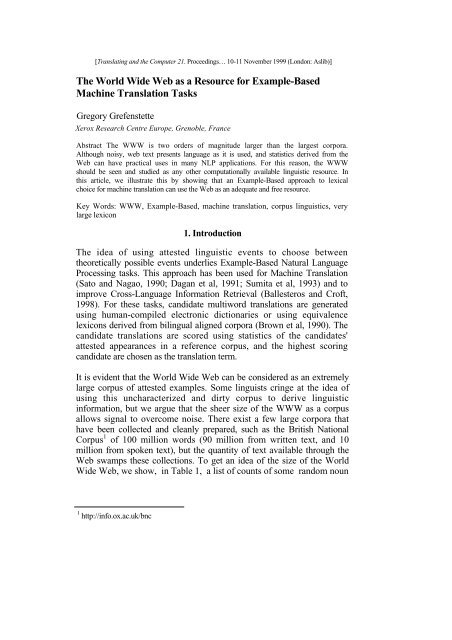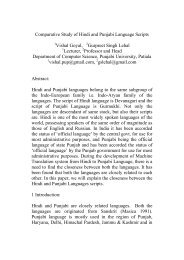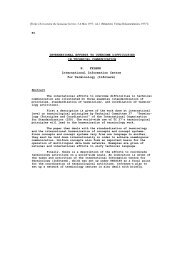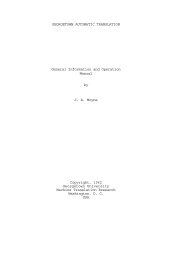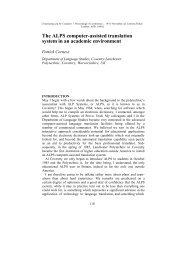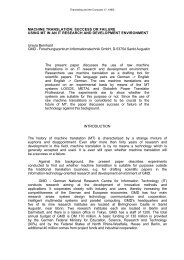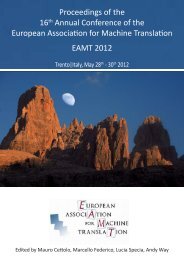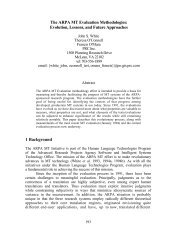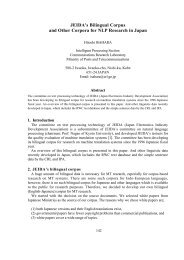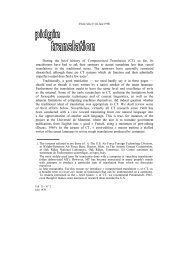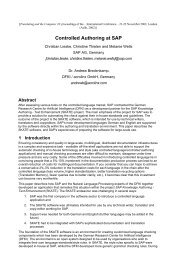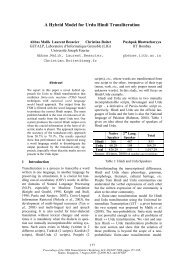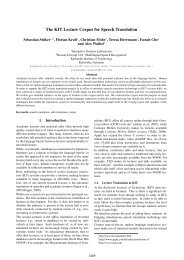Thye World Wide Web as a resource for example-based machine ...
Thye World Wide Web as a resource for example-based machine ...
Thye World Wide Web as a resource for example-based machine ...
You also want an ePaper? Increase the reach of your titles
YUMPU automatically turns print PDFs into web optimized ePapers that Google loves.
[Translating and the Computer 21. Proceedings… 10-11 November 1999 (London: Aslib)]<br />
The <strong>World</strong> <strong>Wide</strong> <strong>Web</strong> <strong>as</strong> a Resource <strong>for</strong> Example-B<strong>as</strong>ed<br />
Machine Translation T<strong>as</strong>ks<br />
Gregory Grefenstette<br />
Xerox Research Centre Europe, Grenoble, France<br />
Abstract The WWW is two orders of magnitude larger than the largest corpora.<br />
Although noisy, web text presents language <strong>as</strong> it is used, and statistics derived from the<br />
<strong>Web</strong> can have practical uses in many NLP applications. For this re<strong>as</strong>on, the WWW<br />
should be seen and studied <strong>as</strong> any other computationally available linguistic <strong>resource</strong>. In<br />
this article, we illustrate this by showing that an Example-B<strong>as</strong>ed approach to lexical<br />
choice <strong>for</strong> <strong>machine</strong> translation can use the <strong>Web</strong> <strong>as</strong> an adequate and free <strong>resource</strong>.<br />
Key Words: WWW, Example-B<strong>as</strong>ed, <strong>machine</strong> translation, corpus linguistics, very<br />
large lexicon<br />
1. Introduction<br />
The idea of using attested linguistic events to choose between<br />
theoretically possible events underlies Example-B<strong>as</strong>ed Natural Language<br />
Processing t<strong>as</strong>ks. This approach h<strong>as</strong> been used <strong>for</strong> Machine Translation<br />
(Sato and Nagao, 1990; Dagan et al, 1991; Sumita et al, 1993) and to<br />
improve Cross-Language In<strong>for</strong>mation Retrieval (Ballesteros and Croft,<br />
1998). For these t<strong>as</strong>ks, candidate multiword translations are generated<br />
using human-compiled electronic dictionaries or using equivalence<br />
lexicons derived from bilingual aligned corpora (Brown et al, 1990). The<br />
candidate translations are scored using statistics of the candidates'<br />
attested appearances in a reference corpus, and the highest scoring<br />
candidate are chosen <strong>as</strong> the translation term.<br />
It is evident that the <strong>World</strong> <strong>Wide</strong> <strong>Web</strong> can be considered <strong>as</strong> an extremely<br />
large corpus of attested <strong>example</strong>s. Some linguists cringe at the idea of<br />
using this uncharacterized and dirty corpus to derive linguistic<br />
in<strong>for</strong>mation, but we argue that the sheer size of the WWW <strong>as</strong> a corpus<br />
allows signal to overcome noise. There exist a few large corpora that<br />
have been collected and cleanly prepared, such <strong>as</strong> the British National<br />
Corpus 1 of 100 million words (90 million from written text, and 10<br />
million from spoken text), but the quantity of text available through the<br />
<strong>Web</strong> swamps these collections. To get an idea of the size of the <strong>World</strong><br />
<strong>Wide</strong> <strong>Web</strong>, we show, in Table 1, a list of counts of some random noun<br />
1 http://info.ox.ac.uk/bnc
phr<strong>as</strong>es in this large British National Corpus and their counts in an<br />
indexed <strong>Web</strong> browser, AltaVista 2 , on a given day in late 1998.<br />
These <strong>example</strong>s show that the number of attestable patterns is almost two<br />
orders of magnitude larger on the <strong>Web</strong> than the number to be found in<br />
the largest available corpora. Statistical techniques, such <strong>as</strong> Example-<br />
B<strong>as</strong>ed methods, rely on the presence of events of to per<strong>for</strong>m well. Many<br />
Example-B<strong>as</strong>ed techniques suffer per<strong>for</strong>mance drop-offs when they try to<br />
make choices using rare events, since the distinction between signal and<br />
noise becomes blurred. The size of the <strong>Web</strong>, however, weakens 3 the<br />
effect of Zipf’s law (Zipf, 1965), since intuitively likely events do<br />
become common enough <strong>for</strong> statistical techniques to work.<br />
As an anecdotal <strong>example</strong> of how the <strong>Web</strong> can be used <strong>as</strong> a <strong>resource</strong> in the<br />
Example-B<strong>as</strong>ed t<strong>as</strong>k of lexical choice in dictionary-b<strong>as</strong>ed <strong>machine</strong><br />
translation, consider the following <strong>example</strong>. Take the compositional<br />
French noun phr<strong>as</strong>e groupe de travail. In the Ox<strong>for</strong>d-Hachette French-<br />
English dictionary, the French word groupe can be translated by the<br />
English words cluster, group, grouping, concern and collective. The<br />
French word travail can be translated by the English words work, labor<br />
2 http://www.AltaVista.com<br />
3<br />
This not to say that noise does not exist, or that every linguistic utterance appearing on<br />
the <strong>Web</strong> is immediately validated by its simple presence. For <strong>example</strong>, the canonical<br />
counter-<strong>example</strong> of "colorless green"' can be found 337 times via AltaVista. But now<br />
that valid utterances do occur thousands of times on the <strong>Web</strong>, the impact of such selfreference<br />
generated noise is diminished.
or labour. The naïve translator h<strong>as</strong> five (from groups) times three (from<br />
travail) possible ways of translating groupe de travail. Now, the<br />
AltaVista search portal allows the <strong>Web</strong> browser user to search <strong>for</strong><br />
adjacent phr<strong>as</strong>es by placing their query in double-quotes. Combining the<br />
possible translations of groupe de travail into all twenty-one possible<br />
noun phr<strong>as</strong>es creatable by simply re-ordering the nouns and<br />
concatenating them to <strong>for</strong>m English phr<strong>as</strong>es, and then submitting these<br />
phr<strong>as</strong>es to this <strong>Web</strong> browser yields, in Table 2, the actual occurrence<br />
statistics in the web pages indexed by this browser. We see that the<br />
phr<strong>as</strong>e work group is much more frequent than all the others, and is the<br />
most likely domain-independent translation in the group 4 .<br />
Going from anecdote to experimentation, we test in the next section the<br />
use of the <strong>World</strong> <strong>Wide</strong> <strong>Web</strong> <strong>as</strong> a <strong>resource</strong> <strong>for</strong> Example-B<strong>as</strong>ed Machine<br />
Translation on a large-scale.<br />
2. Experimentation<br />
In order to per<strong>for</strong>m an objective, large-scale experiment on the adequacy<br />
of the <strong>World</strong> <strong>Wide</strong> <strong>Web</strong> <strong>as</strong> a linguistic <strong>resource</strong> <strong>for</strong> an Example-B<strong>as</strong>ed<br />
Machine Translation t<strong>as</strong>k, we created a gold standard of compositional<br />
compounds from a publicly available electronic bilingual dictionary 5 .<br />
4<br />
Though the morphological variant working group, found 530124 times is the preferred<br />
(<strong>as</strong> well <strong>as</strong> the more frequently occurring) translation.<br />
5<br />
We used the B<strong>as</strong>ic Multilingual Lexicon http://www.icp.qrenet.fr/ELRA/<br />
cata/text_det.html#b<strong>as</strong>mullex, available from the ELRA <strong>as</strong> our dictionary. This<br />
dictionary contains 37,600 senses translated across five languages: English, French,<br />
Spanish, Italian, and German. We used the German-English and Spanish-English parts.
The standard w<strong>as</strong> created by eliminating all phr<strong>as</strong>es in the dictionary<br />
which were not transparent translations of their subparts. We tested two<br />
language directions: German-to-English and Spanish-to-English. To find<br />
compositional noun phr<strong>as</strong>es in this multilingual dictionary, we extracted<br />
two complete sets of all German compound nouns and all Spanish<br />
nominal phr<strong>as</strong>es satisfying the four criteria:<br />
i. [compound] the dictionary entry w<strong>as</strong> decomposable into two other<br />
Spanish or German words found in the dictionary,<br />
ii. [compositionality] the compound term w<strong>as</strong> translated in the English<br />
part of the dictionary by two word phr<strong>as</strong>es,<br />
iii. [transparency] the words in the English translations of the smaller<br />
German or Spanish components permitted the construction of<br />
candidate translations that included the dictionary-given compoundword<br />
translation, and<br />
iv. [ambiguity] there w<strong>as</strong> more than one possible English translation<br />
candidate.<br />
These sets of words, then, correspond to the entire list of German<br />
compounds and Spanish terms in this full-size dictionary such that, if<br />
they were not in the dictionary, their proper English translation could be<br />
constructed from the translation of the subparts of the German word or<br />
Spanish term using that same dictionary. Only such words which had<br />
ambiguous translations were retained. This strategy led to a set of 724<br />
German words constituting our gold standard of potentially ambiguous<br />
compositional German compounds, and a set of 1140 compositional<br />
Spanish terms. With each German word or Spanish term, we also have<br />
their preferred 6 English translations.<br />
For each German word and <strong>for</strong> each Spanish term, we then ignored the<br />
dictionary entry <strong>for</strong> the compound, and created the English candidate<br />
translations <strong>as</strong> if the non-English term were not included in the<br />
dictionary. This situation reproduces what human users must do <strong>for</strong> most<br />
novel German compounds or novel Spanish terms encountered. In each<br />
c<strong>as</strong>e, we created all the possible two word translations using the<br />
decomposed 7 German word and the individual words of the Spanish<br />
terms (ignoring prepositions) and recombining the English translations of<br />
these subparts from the German-to-English or Spanish-to-English sides<br />
of the same dictionary.<br />
6<br />
By preferred, we mean what our dictionary gives <strong>as</strong> a translation of the term. One<br />
might raise the question about whether the dictionary might be wrong in this sense, but<br />
to remain objective, we considered that the dictionary w<strong>as</strong> always right.<br />
7<br />
Decomposed using techniques described in (Schiller, 1996).
Since each of the 724 German compound words w<strong>as</strong> ambiguously<br />
translatable (given the translations of their components in the reference<br />
dictionary), 3556 possible English translations were generated. For the<br />
1140 ambiguous Spanish multiword terms, there were 6186 possible<br />
English translations built using this simple concatenation strategy. Each<br />
possible translation candidate w<strong>as</strong> sent to AltaVista <strong>as</strong> a phr<strong>as</strong>al query,<br />
and the frequency 8 of occurrence of the phr<strong>as</strong>e w<strong>as</strong> noted. To use the<br />
WWW <strong>as</strong> a decision mechanism <strong>for</strong> choosing the proper translation, the<br />
most frequently occurring phr<strong>as</strong>e w<strong>as</strong> chosen <strong>as</strong> the best <strong>example</strong> <strong>for</strong><br />
translating the ambiguous term. This choice w<strong>as</strong> compared against the<br />
actual translation that the dictionary gave <strong>for</strong> them. The results of this<br />
experiment are shown in the Table 3, showing that 86-87% of the choices<br />
were correct.<br />
Here are some <strong>example</strong> of the translation candidates and their AltaVista<br />
frequencies. In the following tables, we give some <strong>example</strong>s of the<br />
German compound words and the Spanish terms with the English<br />
candidate translations that were generated by translating the components.<br />
For each candidate, the number of times that AltaVista had found the<br />
phr<strong>as</strong>e is given <strong>as</strong> AltaVista count. The next two columns show whether<br />
the frequency in<strong>for</strong>mation is sufficient to pick a dictionary-given<br />
translation: if there is the abbreviation DICT in column 5 then the<br />
8 The page frequency. AltaVista returns a count of the number of times that a word or<br />
expression (enclosed in quotes), h<strong>as</strong> been seen on the pages that it indexes, and the<br />
number of WWW pages that contain the term. The counts given in this paper were<br />
calculated in the beginning of 1999, and correspond to the number of pages found.
English candidate translation of the components corresponds to the gold<br />
standard dictionary translation of the German compound or the Spanish<br />
term. The word MAX in the l<strong>as</strong>t column shows which of the English<br />
candidates w<strong>as</strong> most frequent on the <strong>Web</strong> indexed by Altavista 9 . 87% of<br />
the ambiguous German words and 86% of the ambiguous Spanish<br />
multiword terms tested had DICT in column 5 and the word MAX in<br />
column 6, meaning that the most frequent attested candidate on the <strong>Web</strong><br />
w<strong>as</strong> also a gold standard translation of the compound word. For <strong>example</strong><br />
Appartementhaus generates 8 candidate translations: apartment chop,<br />
apartment cut, apartment house, ... of which apartment house is the<br />
most common on the <strong>Web</strong> and the translation given <strong>for</strong> the compound.<br />
On the other hand, Aktienkurs generated 8 translations of which stock<br />
price w<strong>as</strong> the most common but not given in the dictionary. This l<strong>as</strong>t<br />
<strong>example</strong> w<strong>as</strong> counted among the 13% incorrect German c<strong>as</strong>es. Notice in<br />
the tables that many candidates that are not the most frequent ones still<br />
have no-zero frequencies, <strong>for</strong> <strong>example</strong> apple sap, one of the candidate<br />
translations of Apfelsaft still appeared 25 times on the <strong>Web</strong>.<br />
An <strong>example</strong> from the Spanish data shows that this experiment only gives<br />
the most common translations (corresponding to those appearing in the<br />
9 Recent tests from June 1999 estimate that AltaVista indexes about 15% of the static<br />
<strong>Web</strong> pages accessible on the <strong>Web</strong>.
ilingual gold standard dictionary) where<strong>as</strong> in a specific domain, a rarer<br />
translation might be acceptable. For <strong>example</strong>, the experiment erroneously<br />
chooses energy field <strong>as</strong> the translation of campo de fuerz<strong>as</strong>, rather than<br />
the dictionary supplied <strong>for</strong>ce field, but the choice of one or the other may<br />
well depend on the domain or context of application. Here, we are simply<br />
saying that the WWW provides an idea of the most common way of<br />
saying something.<br />
Note that AltaVista does not index noun phr<strong>as</strong>es but merely contiguous<br />
words. These AltaVista counts are a rough estimate of a given noun<br />
phr<strong>as</strong>e. This experiment could also be made more subtle by generating<br />
more varied syntactic <strong>for</strong>ms (such <strong>as</strong> A of B) or through a more intelligent<br />
use of morphological variants, without modifying the way that the<br />
available <strong>Web</strong> browser indexes its pages. Ideally, the <strong>Web</strong> browsers<br />
would per<strong>for</strong>m a more intelligent indexing, extracting not only
contiguous terms but dependency structures that can be derived through<br />
current robust, shallow parsing systems (Appelt et al, 1993; Ait-Moktar<br />
and Chanod, 1997; Grefenstette, 1997). But even in its simple state, this<br />
German and Spanish to English experiment shows that the WWW is a<br />
linguistic <strong>resource</strong> of the same nature and same (though possibly greater)<br />
utility <strong>as</strong> those corpora now used in Natural Language Processing t<strong>as</strong>ks.<br />
3. Conclusion and Perspectives<br />
We have presented an experiment in Example-B<strong>as</strong>ed Natural Language<br />
Processing using the <strong>World</strong> <strong>Wide</strong> <strong>Web</strong> <strong>as</strong> the exemplar linguistic<br />
<strong>resource</strong> <strong>for</strong> decision making. Our experiment w<strong>as</strong> on a much larger<br />
scale than previous ef<strong>for</strong>ts (Dagan et al, 1991; Rackow et al, 1992),<br />
limited to a few dozen words, since we included all the potentially<br />
ambiguous compounds in a large translation dictionary, and worked with<br />
a corpus (the entire WWW visited by AltaVista) that is orders of<br />
magnitude larger than any previously used corpus.
A human (or computer) deciding on the correct translation of<br />
compositional noun phr<strong>as</strong>es would be faced with the same choice <strong>as</strong> that<br />
presented in this Example-B<strong>as</strong>ed Natural Language Processing<br />
experiment. An extremely simple exploitation of the WWW provides the<br />
linguistic <strong>resource</strong>, a relatively free <strong>resource</strong> one might add, to resolve<br />
this choice with 86-87% accuracy.<br />
This experiment argues <strong>for</strong> a greater exploitation and study of the <strong>Web</strong> <strong>as</strong><br />
a linguistic <strong>resource</strong>, and <strong>for</strong> applying techniques of shallow parsing to<br />
create more linguistically in<strong>for</strong>med indexes than those available through<br />
current web portals.<br />
References<br />
Salah Ait-Mokhtar and Jean-Pierre Chanod. 1997. Incremental finite-state parsing.<br />
In ANLP'97, pages 72-79, W<strong>as</strong>hington.<br />
Dougl<strong>as</strong> E. Appelt, Jerry R. Hobbs, John Bear, David Israel, and Mabry Tyson. 1993.<br />
FASTUS: A finite-state processor <strong>for</strong> in<strong>for</strong>mation extraction from real-word text.<br />
In Proceedings IJCAI '93, Chambery, France, August.<br />
Lisa Ballesteros and W. Bruce Croft. 1998. Resolving ambiguity <strong>for</strong> cross-language<br />
retrieval. In W. Bruce Croft, Alistair Moffat, C.J. van Rijsbergen, Ross Wilkinson, and<br />
Justin Zobel, editors, Proceedings of the 21st Annual International ACM SIGIR<br />
Conference on Research and Development in In<strong>for</strong>mation Retrieval, pages 64-71,<br />
Melbourne, Australia, August. ACM Press, New York.<br />
Peter F. Brown, John Cocke, Stephen A. Della Pietra, Vincent J. Della Pietra, Fredrick<br />
Jelinek, Robert L. Mercer, and Paul S. Roossin. 1990.A statistical approach to language<br />
translation. Computational Linguistics, 16(2):79—85.<br />
I. Dagan, I. Atai, and U. Schwall. 1991. Two languages are better than one. In<br />
Proceedings of the 29th Meeting of the ACL, pages 130—137, Berkeley.<br />
Gregory Grefenstette. 1997. SQLET : Short query linguistic expansion techniques:<br />
Palliating one or two-word queries by providing intermediate structure to text. In<br />
RIAO'97, Computer-Assisted In<strong>for</strong>mation Searching on the Internet, Montreal, Canada.<br />
U. Rackow, I. Dagan, and U. Schwall. 1992. Automatic translation of noun compounds.<br />
In Proceedings of COLING'92, pages 1249-1253, Nantes, France, August 23-28.<br />
S. Sato and M. Nagao. 1990. Towards memory-b<strong>as</strong>ed translation. In H. Karlgren, editor,<br />
Proceedings of COLING'90, pages 247-252, Helsinki.<br />
Anne Schiller. 1996. Deutsche flexions- und kompositionsmorphologie mit pc-kimmo.<br />
In Roland Hausser, editor, Linguistische Verifikation: Documentation zur Ersten<br />
Morpholympics 1994, number 34 in Sonderdruck aus Sprache und In<strong>for</strong>mation. Max<br />
Niemeyer Verlag, Tubingen.
E. Sumita, K. Oi, O. Furuse, H. Iida, T. Higuchi, N. Takah<strong>as</strong>hi, and H. Kitano. 1993.<br />
Example-B<strong>as</strong>ed <strong>machine</strong> translation on m<strong>as</strong>sively parallel processors. In Proc. of the<br />
I3th IJCAI, pages 1283-1288, Chambery, France.<br />
G. K. Zipf. 1965. Human Behavior and the Principle of Le<strong>as</strong>t Ef<strong>for</strong>t. Hafner, New<br />
York.


